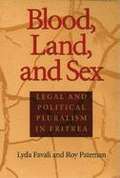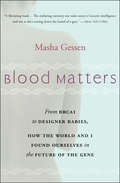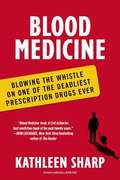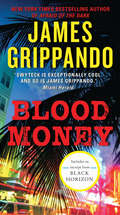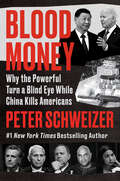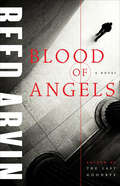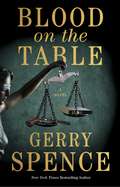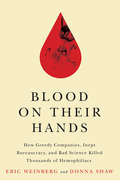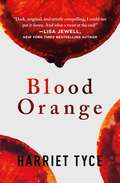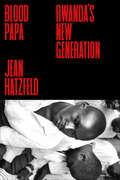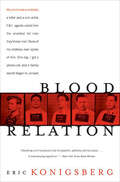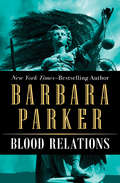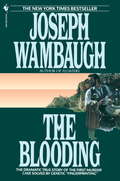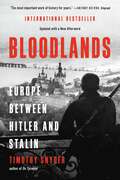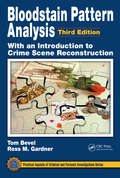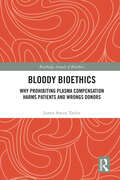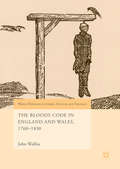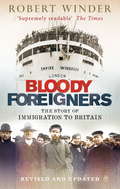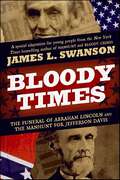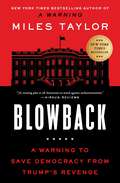- Table View
- List View
Blood, Land, and Sex: Legal and Political Pluralism in Eritrea
by Lyda Favali Roy PatemanEritrea is a small country in northeast Africa on the Red Sea across from Yemen; it has a population of about 3.5 million. Its capital is Asmara. Djibouti is to its southeast, Ethiopia to its south and Sudan to its west. Eritrea's population was in the past organized on the kinship system and has been under Italian and Ethiopian domination but is now independent. This small country has many languages, many customs and several religions. In Eritrea, State, traditional, and religious laws are equally prevalent, but any one legal system may be put into play depending upon the individual or individuals involved in a legal dispute. Because of conflicting laws, it has been difficult for Eritreans to come to a consensus on what constitutes their legal system. In this book, the authors examine the roles of the state, ethnic groups, religious groups, and the international community in several key areas of Eritrean law--blood feud and murder, land tenure, gender relations (marriage, prostitution, rape), and female genital mutilation. Favali and Pateman explore the intersections of the various laws and discuss how change can be brought to communities where legal ambiguity prevails, often to the grave harm of women and other powerless individuals. This significant book focuses on how Eritrea and other newly emerging democracies might build pluralist legal systems that will be acceptable to an ethnically and religiously diverse population. LYDA FAVALI is a lawyer and researcher at the University of Turin, Italy. ROY PATEMAN is Professor Emeritus of Political Science at the University of California, Los Angeles.
Blood Matters: From BRCA1 to Designer Babies, How the World and I Found Ourselves in the Future of the Gene
by Masha GessenA National Book Award winner&’s personal journey through the ethical dilemmas and unsettling choices raised by the new frontier of DNA testing. Several years after Masha Gessen&’s mother died of breast cancer, she discovered she too had the BRCA1 gene mutation, which predisposes women to high rates of ovarian and breast cancer. Her doctors gave her narrow options: surgical removal of her breasts and ovaries or living with the likelihood of one day developing cancer. As Gessen wrestled with her own health decisions, she sought more information about the implications of genetic testing from a variety of sources—ranging from others faced with her same dilemma to medical researchers, historians, and religious thinkers. With concerns both practical and philosophical, personal and societal, her inquiry led her across the globe, with stops in Israel, Russia, Austria, and the United States. Weaving her own story into her journalistic research, Gessen offers insight into how knowledge that was once unimaginable now shapes our lives. Blood Matters explores not only the decisions we must make in our physical and emotional health, but also the ethical choices we face when choosing spouses or having children. &“Valuable reading to almost anyone facing a huge health decision, not only for the literary commiseration it offers, but also for the inspired example of medical sleuthing on one&’s own behalf that it provides. Gessen keeps an inflammatory topic at room temperature, writing elegantly and without self pity.&” —The New York Times Book Review
Blood Medicine
by Kathleen Sharp“Blood Feud rivals A Civil Action for best non-fiction book of the past twenty years. ” — John Lescroart, New York Times bestselling author of Damage Procrit seemed like a biotech miracle, promising a golden age in medical care. Developed in the 1980s by Amgen and licensed to the pharmaceutical giant, Johnson & Johnson, the drug (AKA Epogen and Aranesp) soon generated billions in annual revenue—and still does. In 2012, world famous cyclist, Olympian, and Tour de France champion Lance Armstrong was banned from professional cycling on doping charges for using EPO (the blanket name for the drugs Procrit and Epogen), resulting in a global controversy about abuse, big pharmaceutical companies, and the lies and inaccuracies concerning performance-enhancing drugs. Mark Duxbury was a J&J salesman who once believed in the blood-booster, setting record sales and winning company awards. Then Duxbury started to learn unsavory truths about Procrit and J&J’s business practices. He was fired and filed a whistleblower suit to warn the public. When Jan Schlichtman (A Civil Action) learned of Duxbury’s crusade, he signed on. Now, he’s fighting on behalf of cancer patients and for every American who trusts Big Pharma with his life. .
Blood Money (Jack Swyteck #10)
by James Grippando<P>New York Times bestselling author James Grippando delivers a powerful, nonstop thrill ride ripped from the headlines. <P>Miami criminal defense attorney Jack Swyteck is back in his most frightening case yet, and this time the price of victory is measured in blood. It is the most sensational murder trial since O. J. Simpson's. The nation is obsessed with Sydney Bennett, a sexy nightclub waitress and good-time girl accused of murdering her two-year-old daughter for cramping her party life. When he had agreed to defend Sydney, Jack Swyteck knew he'd be taking on the toughest and most controversial case of his career. <P>Millions of "TV jurors" have convicted Sydney in the court of public opinion. When the shocking verdict of not guilty is announced, citizens across the country are outraged, and Jack is bombarded by the fallout: angry, profanity-laced phone calls and even outright threats. Media-fed rumors of "blood money"-purported seven-figure book and movie deals-ratchet up the hysteria, putting Jack's client and everyone around her at risk. <P>On the night of Sydney's release, an angry mob outside the jail has gathered to serve its own justice. In the frenzy, an innocent young woman bearing a striking resemblance to the reviled Sydney Bennett ends up in a coma. While the media blame Jack and his defense team, the victim's parents reach out to him, requesting his help. <P>They don't believe the attack was the tragic result of random mob violence. Searching for the truth about what happened that night, Jack makes a frightening discovery. Larger and much more powerful forces are working in the shadows, and what happened outside the jail is a symptom of an evil that infected the show-stopping trial and media-spun phenomenon of Sydney Bennett.
Blood Money: Why the Powerful Turn a Blind Eye While China Kills Americans
by Peter SchweizerAN INSTANT #1 NEW YORK TIMES BESTSELLERIt’s often said that China is in a cold war with America. The reality is far worse: the war is hot, and the body count is one-sided.China is killing Americans and working aggressively to maximize the carnage while our leaders remain passive and, in some cases, compliant. Why?If anyone could crack the code, it’s the renowned nonpartisan investigator Peter Schweizer. Schweizer’s previous three number one New York Times bestsellers sent shock waves through official Washington, sparking FBI investigations and congressional probes that continue to this day.For Blood Money, Schweizer and his team of forensic investigators spent more than two years scouring a trove of restricted Chinese military documents, data-mining a mountain of American financial records, and tracking US political leaders’ investments and family businesses. Schweizer unloads bombshell after bombshell, exposing the Chinese Communist Party’s covert operations in the American drug trade, social justice movement, and medical establishment to sow chaos and decadence in the United States.A towering achievement of investigative journalism, Blood Money is one of those rare books that makes you clearly see the world anew.
Blood of Angels
by Reed Arvin“...another winner that thriller, mystery and general fiction readers alike will relish.” — Publishers Weekly (starred review)“Arvin weaves together disparate elements into a coherent and often thought-provoking tale.” — Pittsburgh Tribune“Intriguing...clever. A-” — Entertainment Weekly“A suspenseful story line that takes hold of the reader from the very beginning to the book’s close.” — New York Law Journal“(BLOOD OF ANGELS is) the kind of book that makes ‘unputdownable’ and ‘page-turner’more than just cliches.” — Chicago Tribune Books“Fast-paced action, unexpected twists…keeps the pages turning until the end.” — Denver Post“Tense, evocative prose...fiendishly clever and eloquently penned. — Providence Journal“Arvin weaves his plot and his chacters together with remarkable empathy...A legal thriller with soul.” — Wichita Eagle“An old-fashioned thriller with modern-technology smarts.” — Chicago Tribune Books“...the first summer-movie blockbuster of the year.” — Kirkus Reviews (Starred Review)“Absorbing...briskly paced (with) realistic characters whose fervent beliefs shape their actions.” — The Record (Bergen County, NJ)“Arvin piles on the action in this nail-biting Tennessee tale of misplaced revenge.” — New Orleans Times-Picayune“The pace is fast and...Arvin saves a satisfying surprise for the finale.” — Boston Globe“Briskly-paced...a fresh approach to the thriller.” — Fort Lauderdale Sun-Sentinel“This nail-biter is Arvin’s third thriller...and each has been better than the last.” — Booklist (starred review)“Arvin keeps the action swift and the tension high.” — Calgary Sun
Blood on the Table: A Novel
by Gerry SpenceBlood on the Table brings to life the same powerful emotions and riveting excitement that Gerry Spence evoked from juries when the blood was real. Blood on the Table is a blend of darkness, sex, and violence, with characters who are far from perfect and often are their own worst enemies. Spence takes the reader to savage—back country Wyoming, where an eleven-year-old boy must take the witness stand against a vicious prosecutor, corrupt police, and a prejudiced judge, to keep his family safe.At the Publisher's request, this title is being sold without Digital Rights Management Software (DRM) applied.
Blood on Their Hands: How Greedy Companies, Inept Bureaucracy, and Bad Science Killed Thousands of Hemophiliacs
by Eric Weinberg Donna ShawA few short years after HIV first entered the world blood supply in the late 1970s and early 1980s, over half the hemophiliacs in the United States were infected with the virus. But this was far more than just an unforeseeable public health disaster. Negligent doctors, government regulators, and Big Pharma all had a hand in this devastating epidemic. Blood on Their Hands is an inspiring, firsthand account of the legal battles fought on behalf of hemophiliacs who were unwittingly infected with tainted blood. As part of the team behind the key class action litigation filed by the infected, young New Jersey lawyer Eric Weinberg was faced with a daunting task: to prove the negligence of a powerful, well-connected global industry worth billions. Weinberg and journalist Donna Shaw tell the dramatic story of how idealistic attorneys and their heroic, mortally-ill clients fought to achieve justice and prevent further infections. A stunning exposé of one of the American medical system’s most shameful debacles, Blood on Their Hands is a rousing reminder that, through perseverance, the victims of corporate greed can sometimes achieve great victory.
Blood Orange
by Harriet TyceA young lawyer's outwardly perfect life spirals out of control as she takes on her first murder case in this dark and twisty debut thriller for readers of Paula Hawkins, A.J. Finn, or Shari Lapena.Alison has it all. A doting husband, adorable daughter, and a career on the rise--she's just been given her first murder case to defend. But all is never as it seems... Just one more night. Then I'll end it. Alison drinks too much. She's neglecting her family. And she's having an affair with a colleague whose taste for pushing boundaries may be more than she can handle.I did it. I killed him. I should be locked up. Alison's client doesn't deny that she stabbed her husband - she wants to plead guilty. And yet something about her story is deeply amiss. Saving this woman may be the first step to Alison saving herself.I'm watching you. I know what you're doing.But someone knows Alison's secrets. Someone who wants to make her pay for what she's done, and who won't stop until she's lost everything....
Blood Papa: Rwanda's New Generation
by Jean HatzfeldThe continuation of a groundbreaking study of the Rwandan genocide, and the story of the survivor generationIn Rwanda from April to June 1994, 800,000 Tutsis were slaughtered by their Hutu neighbors in the largest and swiftest genocide since World War II. In his previous books, Jean Hatzfeld has documented the lives of the killers and victims, but after twenty years he has found that the enormity of understanding doesn’t stop with one generation. In Blood Papa, Hatzfeld returns to the hills and marshes of Nyamata to ask what has become of the children—those who never saw the machetes yet have grown up in the shadow of tragedy.Fabrice, Sandra, Jean-Pierre, and others share the genocide as a common inheritance. Some have known only their parents’ silence and lies, enduring the harassment of classmates or the stigma of a father jailed for unspeakable crimes. Others have enjoyed a loving home and the sympathies offered to survivor children, but do so without parents or an extended family. The young Rwandans in Blood Papa see each other in the neighborhood—they dance and gossip, frequent the same cafés, and, like teenagers everywhere, love sports, music, and fashion; they surf the Web and dream of marriage. Yet Hutu and Tutsi children rarely speak of the ghosts that haunt their lives. Here their moving first-person accounts combined with Hatzfeld’s arresting chronicles of everyday life form a testament to survival in a country devastated by the terrible crimes and trauma of the past.
Blood, Powder, and Residue: How Crime Labs Translate Evidence into Proof
by Beth A. BechkyA rare behind-the-scenes look at the work of forensic scientistsThe findings of forensic science—from DNA profiles and chemical identifications of illegal drugs to comparisons of bullets, fingerprints, and shoeprints—are widely used in police investigations and courtroom proceedings. While we recognize the significance of this evidence for criminal justice, the actual work of forensic scientists is rarely examined and largely misunderstood. Blood, Powder, and Residue goes inside a metropolitan crime laboratory to shed light on the complex social forces that underlie the analysis of forensic evidence.Drawing on eighteen months of rigorous fieldwork in a crime lab of a major metro area, Beth Bechky tells the stories of the forensic scientists who struggle to deliver unbiased science while under intense pressure from adversarial lawyers, escalating standards of evidence, and critical public scrutiny. Bechky brings to life the daily challenges these scientists face, from the painstaking screening and testing of evidence to making communal decisions about writing up the lab report, all while worrying about attorneys asking them uninformed questions in court. She shows how the work of forensic scientists is fraught with the tensions of serving justice—constantly having to anticipate the expectations of the world of law and the assumptions of the public—while also staying true to their scientific ideals.Blood, Powder, and Residue offers a vivid and sometimes harrowing picture of the lives of highly trained experts tasked with translating their knowledge for others who depend on it to deliver justice.
Blood Relation
by Eric KonigsbergA New Yorker writer investigates the life and career of his hit-man great-uncle and the impact on his family.Growing up in a household as generic as Midwestern Jews get, author Eric Konigsberg always wished there was something different about his family, something exotic and mysterious, even shocking. When he was sent off to boarding school, he learned from an ex-cop security guard that there was: His great-uncle Harold, in prison in upstate New York, was a legendary Mafia enforcer, suspected by the FBI of upwards of twenty murders.Konigsberg had uncovered a shameful, long-hidden family secret. His grandfather, a Jewish Horatio Alger story who had become a respected merchant through honesty and hard work, never spoke of his baby brother. When other relatives could be coaxed into talking about him, he wasn't "Kayo" Konigsberg, the "smartest hit man" and "toughest Jew" described by cops and associates; he was Uncle Heshy, the loudmouth nogoodnik and smalltime con, long since written off as dead. Intrigued, Konigsberg ignored his family's protests and arranged a meeting, which inspired the acclaimed New Yorker piece this book is based on.In Blood Relation, Konigsberg portrays Harold as a fascinating, paradoxical character: both brutal and winning, a cold-blooded killer and a larger-than-life charmer who taught himself to read as an adult and served as his own lawyer in two major trials, to riotous effect. Functioning by turns as Kayo's pursuer, jailhouse scribe, pawn, and antagonist, Konigsberg traces his great-uncle's checkered and outlandish life and investigates his impact on his family and others who crossed his path, weaving together strands of family, Jewish identity, justice, and post-war American history.
Blood Relations
by Barbara ParkerFrom New York Times-bestselling author and former Miami prosecutor Barbara Parker comes a spellbinding legal thriller about a sexual attack at a South Beach nightclub that has shocking repercussions for the victim, the three suspects, and an idealistic prosecutor Sam Hagen's eighteen years as a prosecutor haven't inured him to violence, even in Miami, where murder has become almost routine. Now a seventeen-year-old model named Ali D. claims she was gang-raped in the VIP room of a South Beach nightclub. Trouble is, two of the men she's accusing are Miami movers and shakers: Marquis Lamont, pro-footballer turned actor, and connected Italian businessman Klaus Ruffini, who owns a high-profile property in South Beach. Under political pressure from the state's attorney, Hagen is expected to dismiss the case for lack of evidence. At home, his marriage is crumbling and he finds his moral certitude tested when he rekindles an affair with model-turned-photographer Caitlin Dorn. Now Hagen's about to make more enemies: He decides to pursue the rape investigation, which soon erupts in murder. Caught up in a maelstrom of violence and suspicion, this seasoned prosecutor must race to solve an out-of-control case.
Blood-Stained Kings
by Tim WillocksTom Willock’s first book, Green River Rising, earned the kind of reviews that are rarely accorded to most so-called literary thrillers. This remarkable debut was hailed for its rich, powerful writing as well as its dramatic, page-turning suspense. The New York Times Book Review called it “beautifully vivid” and “triumphantly realized,” while People called it “as fine a thriller as one could ask for.” The author’s much-anticipated second novel is as powerful and ambitious as its predecessor. Set in New Orleans and the rural South, it is the story of a chain of cataclysmic events let loose by the murder of Clarence Jefferson, a legendary lawman who has gathered a cache of evidence that could imprison corrupt politicians in five states. His last act, it appears, was to handpick two people as the unlucky heirs of his potentially explosive evidence files. The pair must either dispose of them as fast as they can or—at considerable risk to themselves—deliver the files to the authorities. Lenna Parillaud and Dr. Cicero Grimes, Jefferson’s “beneficiaries,” have never met. Lenna, a millionaire businesswoman, has been racked by grief and rage over the loss of her daughter. Dr. Grimes is a clinically depressed psychiatrist. Though both have burdens enough of their own, they are swept up into this story of Southern violence, passion, and vengeance, the likes of which perhaps only the readers of Willocks’s previous novel can imagine. Compared by critics to Norman Mailer, James Ellroy, Stephen Hunter, and Andrew Vachss, Willocks offers a unique amalgam of gritty realism and something more—a depth and intensity that is seldom achieved in popular fiction.
The Blooding
by Joseph WambaughFifteen-year-old Lynda Mann's savagely raped and strangled body is found along a shady footpath near the English village of Narborough. Though a massive 150-man dragnet is launched, the case remains unsolved. Three years later the killer strikes again, raping and strangling teenager Dawn Ashforth only a stone's throw from where Lynda was so brutally murdered. But it will take four years, a scientific breakthrough, the largest manhunt in British crime annals, and the blooding of more than four thousand men before the real killer is found.
The Blooding
by Joseph WambaughFor the first time, Joseph Wambaugh turns his attention outside the United States to deal with two murders in neighboring English Midlands villages-ancient villages that still have whitewashed Tudor cottages, pavements too narrow for passing baby prams, streets barely wide enough for two cars, and churches or pubs as the sites of community life. What intrigues the master of true-crime writing is that out of the sleepy setting grew a landmark case: the first murders solved by genetic fingerprinting. The victims of the terrifying rape-murders -two fifteen-year-old girls who do not know each other-have in common one fatal mistake: they choose to walk village footpaths bordering the lands of a psychiatric hospital. Forever after, the names Ten Pound Lane and The Black Pad will evoke fear and dread. The murders occur three years apart, and during all those years the members of the Leicestershire constabulary never give up their search. The local newspapers cooperate by keeping the cases alive. And the families of the victims try to cope with the chaos of their existence.
Bloodlands: Europe Between Hitler and Stalin
by Timothy SnyderAmericans think of World War II as "The Good War. ” But before it even began, America’s ally Stalin had shot and starved millions of his own citizens; he would continue to do so throughout the war. American soldiers liberated concentration camps, but they never reached the death factories, killing fields, and starvation sites in the East where Hitler and Stalin murdered civilians on a massive scale. In twelve years, in deliberate killing policies unrelated to combat, the Nazi and Soviet regimes killed fourteen million people in a zone of death between Berlin and Moscow. At war’s end, these bloodlands fell behind the iron curtain, leaving their history in darkness. In Bloodlands, acclaimed historian Timothy Snyder offers a groundbreaking investigation of the place where Europeans were murdered by the millions, providing a fresh account of the atrocities perpetrated by the two regimes. Assiduously researched, deeply humane, and utterly definitive, Bloodlands is required reading for anyone seeking to understand the central tragedy of modern history.
Bloodstain Pattern Analysis with an Introduction to Crime Scene Reconstruction (ISSN)
by Ross M. Gardner Tom BevelObjective establishment of the truth is the goal of any good crime scene investigator. This demands a consideration of all evidence available using proven scientific methodologies to establish objective snapshots of the crime. The majority of forensic disciplines shed light on thewho of a crime, bloodstain pattern analysis is one of the most imp
Bloodtaking and Peacemaking: Feud, Law, and Society in Saga Iceland
by William Ian MillerDubbed by the New York Times as "one of the most sought-after legal academics in the county," William Ian Miller presents the arcane worlds of the Old Norse studies in a way sure to attract the interest of a wide range of readers. Bloodtaking and Peacemaking delves beneath the chaos and brutality of the Norse world to discover a complex interplay of ordering and disordering impulses. Miller's unique and engaging readings of ancient Iceland's sagas and extensive legal code reconstruct and illuminate the society that produced them. People in the saga world negotiated a maze of violent possibility, with strategies that frequently put life and limb in the balance. But there was a paradox in striking the balance-one could not get even without going one better. Miller shows how blood vengeance, law, and peacemaking were inextricably bound together in the feuding process. This book offers fascinating insights into the politics of a stateless society, its methods of social control, and the role that a uniquely sophisticated and self-conscious law played in the construction of Icelandic society. "Illuminating. "-Rory McTurk, Times Literary Supplement "An impressive achievement in ethnohistory; it is an amalgam of historical research with legal and anthropological interpretation. What is more, and rarer, is that it is a pleasure to read due to the inclusion of narrative case material from the sagas themselves. "-Dan Bauer, Journal of Interdisciplinary History
Bloody Bioethics: Why Prohibiting Plasma Compensation Harms Patients and Wrongs Donors (Routledge Annals of Bioethics)
by James Stacey TaylorThis is the first book to argue in favor of paying people for their blood plasma. It does not merely argue that offering compensation to plasma donors is morally permissible. It argues that prohibiting donor compensation is morally wrong—and that it is morally wrong for all of the reasons that are offered against allowing donor compensation. Opponents of donor compensation claim that it will reduce the amount and quality of plasma obtained, exploit and coerce donors, and undermine social cohesion. James Stacey Taylor argues that empirical evidence demonstrates that compensating plasma donors greatly increases the amount of plasma obtained with no adverse effects on the quality of the pharmaceutical products that are manufactured from it. Prohibiting compensation thus harms patients by reducing their access to the medicines they need. He also argues that it is the prohibition of compensation—not its offer—that exploits donors, fails to respect the moral need to secure a person’s authoritative consent to her treatment, and prevents donors from giving their informed consent to donate. Prohibiting compensation thus not only harms patients but also wrongs donors. Bloody Bioethics will appeal to researchers, advanced students, and medical professionals interested in bioethics, moral philosophy, and the moral limits of markets.
The Bloody Code in England and Wales, 1760–1830 (World Histories of Crime, Culture and Violence)
by John WallissThis book is a comparative quantitative analysis of the administration of justice across four English and three Welsh counties between 1760 and 1830. Drawing on a dataset of over 22,000 indictments, the book explores the similarities and differences between how the so-called Bloody Code was administered between, on the one hand, England and Wales, and, on the other, individual English and Welsh counties. The book is structured in two sections that trace the criminal justice process in England and Wales respectively. The first chapter in each section examines the pattern of indictments in the respective counties, and explores the crimes for which men and women were indicted, the verdicts handed down, and the sentences passed. The second chapter then explores patterns of sentences of death, executions and pardons for those capitally convicted of serious crimes against the person and forms of property offences.
Bloody Foreigners: The Story of Immigration to Britain
by Robert WinderImmigration is one of the most important stories of modern British life, yet it has been happening since Caesar first landed in 53 BC. Ever since the first Roman, Saxon, Jute and Dane leaped off a boat we have been a mongrel nation. Our roots are a tangled web. From Huguenot weavers fleeing French Catholic persecution in the 18th century to South African dentists to Indian shopkeepers; from Jews in York in the 12th century (who had to wear a yellow star to distinguish them and who were shamefully expelled by Edward I in 1272) to the Jamaican who came on board the Windrush in 1947. The first Indian MP was elected in 1892, Walter Tull, the first black football player played (for Spurs and Northampton) before WW1 (and died heroically fighting for the allies in the last months of the war); in 1768 there were 20,000 black people in London (out of a population of 600,000 - a similar percentage to today). The 19th century brought huge numbers of Italians, Irish, Jews (from Russia and Poland mainly), Germans and Poles. This book draws all their stories together in a compelling narrative.
Bloody Foreigners: The Story of Immigration to Britain
by Robert WinderImmigration is one of the most important stories of modern British life, yet it has been happening since Caesar first landed in 53 BC. Ever since the first Roman, Saxon, Jute and Dane leaped off a boat we have been a mongrel nation. Our roots are a tangled web. From Huguenot weavers fleeing French Catholic persecution in the 18th century to South African dentists to Indian shopkeepers; from Jews in York in the 12th century (who had to wear a yellow star to distinguish them and who were shamefully expelled by Edward I in 1272) to the Jamaican who came on board the Windrush in 1947. The first Indian MP was elected in 1892, Walter Tull, the first black football player played (for Spurs and Northampton) before WW1 (and died heroically fighting for the allies in the last months of the war); in 1768 there were 20,000 black people in London (out of a population of 600,000 - a similar percentage to today). The 19th century brought huge numbers of Italians, Irish, Jews (from Russia and Poland mainly), Germans and Poles. This book draws all their stories together in a compelling narrative.
Bloody Times: The Funeral of Abraham Lincoln and the Manhunt for Jefferson Davis
by James L. SwansonNew York Times bestselling author James L. Swanson brings to life the fast-paced, suspense-filled story of Abraham Lincoln's and Jefferson Davis's final journeys through our wounded nation following the Civil War. This middle grade nonfiction book is an excellent choice for tween readers in grades 7 to 8, especially during homeschooling. It’s a fun way to keep your child entertained and engaged while not in the classroom.This suspense-filled true-crime thriller—the young readers’ adaptation of Swanson’s BloodyCrimes—explores two epic events of the Civil War era: the manhunt to apprehend Confederate president Jefferson Davis in the wake of Abraham Lincoln’s assassination and the momentous 20-day funeral pageant that brought President Lincoln’s body from Washington, DC to his home in Springfield. Full of fascinating twists and turns, and lavishly illustrated with dozens of rare historical images, Bloody Times captures the riveting stories of these two fallen leaders who changed the course of history. It’s perfect for young readers who enjoy dramatic nonfiction tales from the likes of Steve Sheinkin and Patricia McCormick.This book contains a note from the author, a glossary, a list of important Civil War figures, and a guide to visiting the historic sites mentioned within. A companion to the bestselling and highly acclaimed Chasing Lincoln's Killer.
Blowback: A Warning to Save Democracy from the Next Trump
by Miles TaylorINSTANT NEW YORK TIMES BESTSELLER The author behind the &“eye-popping&” (CNN) #1 New York Times bestseller A Warning presents an urgent look at how our deeply divided nation is setting the stage for &“The Next Trump.&”Donald Trump will be president again, whether he is on the ballot or not. That is because Trumpism is overtaking the Republican Party and will mount a vigorous comeback, potentially in the hands of a savvier successor—The Next Trump. This prophecy will come true, according to Miles Taylor, if we do not learn the lessons of the recent past. With the 2024 election approaching, the formerly &“Anonymous&” official is back with bombshell revelations and a sobering national forecast. Through interviews with dozens of ex-Trump aides and government leaders, Taylor predicts what could happen inside &“Trump 2.0,&” the White House of a more competent and more formidable copycat. What sounds like a political thriller—from shadowy presidential powers and CIA betrayals to angry henchmen and assassination plots—is instead America&’s political reality, as Taylor uses untold stories to shed light on the ex-President&’s unfulfilled plans, the dark forces haunting our civic lives, and how we can thwart the rise of extremism in the United States. Blowback is also a surprisingly emotional and self-critical portrait of a dissenter, whose own unmasking provides a vivid warning about what happens when we hide the truth from others and, most importantly, ourselves.
